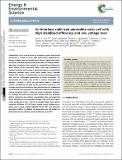| dc.contributor.author | Yoo, Jason Jungwan | |
| dc.contributor.author | Wieghold, Sarah | |
| dc.contributor.author | Sponseller, Melany C. | |
| dc.contributor.author | Chua, Matthew R. | |
| dc.contributor.author | Bertram, Sophie N. | |
| dc.contributor.author | Hartono, Noor Titan Putri | |
| dc.contributor.author | Tresback, Jason S. | |
| dc.contributor.author | Hansen, Eric C. | |
| dc.contributor.author | Correa-Baena, Juan-Pablo | |
| dc.contributor.author | Bulovic, Vladimir | |
| dc.contributor.author | Buonassisi, Tonio | |
| dc.contributor.author | Shin, Seong Sik | |
| dc.contributor.author | Bawendi, Moungi G. | |
| dc.date.accessioned | 2020-04-24T19:42:56Z | |
| dc.date.available | 2020-04-24T19:42:56Z | |
| dc.date.issued | 2019-06 | |
| dc.date.submitted | 2019-03 | |
| dc.identifier.issn | 1754-5692 | |
| dc.identifier.issn | 1754-5706 | |
| dc.identifier.uri | https://hdl.handle.net/1721.1/124871 | |
| dc.description.abstract | Stabilization of the crystal phase of inorganic/organic lead halide perovskites is critical for their high performance optoelectronic devices. However, due to the highly ionic nature of perovskite crystals, even phase stabilized polycrystalline perovskites can undergo undesirable phase transitions when exposed to a destabilizing environment. While various surface passivating agents have been developed to improve the device performance of perovskite solar cells, conventional deposition methods using a protic polar solvent, mainly isopropyl alcohol (IPA), results in a destabilization of the underlying perovskite layer and an undesirable degradation of device properties. We demonstrate the hidden role of IPA in surface treatments and develop a strategy in which the passivating agent is deposited without destabilizing the high quality perovskite underlayer. This strategy maximizes and stabilizes device performance by suppressing the formation of the perovskite δ-phase and amorphous phase during surface treatment, which is observed using conventional methods. Our strategy also effectively passivates surface and grain boundary defects, minimizing non-radiative recombination sites, and preventing carrier quenching at the perovskite interface. This results in an open-circuit-voltage loss of only ∼340 mV, a champion device with a power conversion efficiency of 23.4% from a reverse current–voltage scan, a device with a record certified stabilized PCE of 22.6%, and enhanced operational stability. In addition, our perovskite solar cell exhibits an electroluminescence external quantum efficiency up to 8.9%. ©2019 | en_US |
| dc.description.sponsorship | Institute for Soldier Nanotechnology (Grant W911NF-13-D-0001) | en_US |
| dc.description.sponsorship | NASA (Grant NNX16AM70H) | en_US |
| dc.description.sponsorship | DOE Division of Materials Sciences and Engineering (Award DE-FG02-07ER46454) | en_US |
| dc.description.sponsorship | NSF (Grant CBET-1605495) | en_US |
| dc.publisher | Royal Society of Chemistry (RSC) | en_US |
| dc.relation.isversionof | 10.1039/c9ee00751b | en_US |
| dc.rights | Creative Commons Attribution Noncommercial 3.0 unported license | en_US |
| dc.rights.uri | https://creativecommons.org/licenses/by-nc/3.0/ | en_US |
| dc.source | Royal Society of Chemistry (RSC) | en_US |
| dc.subject | Renewable Energy, Sustainability and the Environment | en_US |
| dc.subject | Nuclear Energy and Engineering | en_US |
| dc.subject | Pollution | en_US |
| dc.subject | Environmental Chemistry | en_US |
| dc.title | An interface stabilized perovskite solar cell with high stabilized efficiency and low voltage loss | en_US |
| dc.type | Article | en_US |
| dc.identifier.citation | Yoo, Jason J. et al. "An interface stabilized perovskite solar cell with high stabilized efficiency and low voltage loss." Energy & Environmental Science, 12, 7 (June 2019): 2192--2199 © 2019 Royal Society of Chemistry | en_US |
| dc.contributor.department | Massachusetts Institute of Technology. Department of Chemistry | en_US |
| dc.contributor.department | Massachusetts Institute of Technology. Department of Mechanical Engineering | en_US |
| dc.contributor.department | Massachusetts Institute of Technology. Department of Electrical Engineering and Computer Science | en_US |
| dc.relation.journal | Energy & environmental science | en_US |
| dc.eprint.version | Final published version | en_US |
| dc.type.uri | http://purl.org/eprint/type/JournalArticle | en_US |
| eprint.status | http://purl.org/eprint/status/PeerReviewed | en_US |
| dspace.date.submission | 2019-07-18T12:58:10Z | |
| mit.journal.volume | 12 | en_US |
| mit.journal.issue | 7 | en_US |
| mit.metadata.status | Complete | |
